Related Research Articles

Kent State University (KSU) is a public research university in Kent, Ohio, United States. The university includes seven regional campuses in Northeast Ohio located in Ashtabula, Burton, East Liverpool, Jackson Township, New Philadelphia, Salem, and Warren, along with additional regional and international facilities in Cleveland, Independence, and Twinsburg, Ohio; New York City; and Florence, Italy.
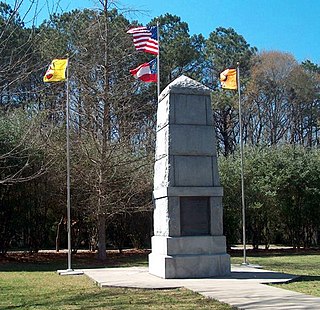
The Trail of Tears was the forced displacement of approximately 60,000 people of the "Five Civilized Tribes" between 1830 and 1850, and the additional thousands of Native Americans and their enslaved African Americans within that were ethnically cleansed by the United States government.

Portage County is a county in the U.S. state of Ohio. As of the 2020 census, the population was 161,791. Located in Northeast Ohio, Portage County is part of the Akron Metropolitan Statistical Area, which is also included in the Cleveland–Akron–Canton Combined Statistical Area. Its county seat is Ravenna and its largest city is Kent. The county, named for the portage between the Cuyahoga and Tuscarawas rivers, was created in 1807 and formally organized in 1808. In addition to the cities of Kent and Ravenna, Portage County also includes the cities of Aurora and Streetsboro, along with five villages, 18 civil townships, and several unincorporated places within those townships. Additionally, the county includes parts of the city of Tallmadge, and part of the village of Mogadore, both of which are mostly in neighboring Summit County.
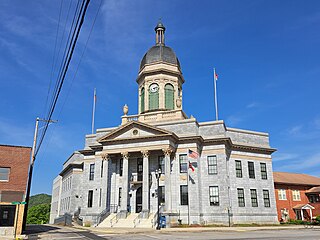
Cherokee County is the westernmost county in the U.S. state of North Carolina. It borders Tennessee to its west and Georgia to its south. As of the 2020 census, the population was 28,774. The county seat is Murphy.
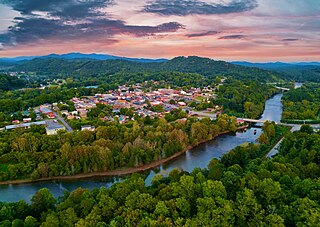
Murphy is a town in and the county seat of Cherokee County, North Carolina, United States. It is situated at the confluence of the Hiwassee and Valley rivers. It is the westernmost county seat in the state of North Carolina, approximately 360 miles (580 km) from the state capital in Raleigh. The population of Murphy was 1,608 at the 2020 census.

Hayesville is a town in Clay County, North Carolina, United States. The population was 311 at the 2010 census. It is the county seat of Clay County.
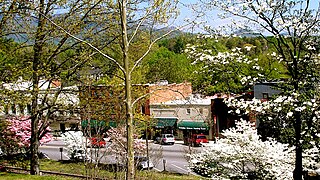
Tryon is a town in Polk County, on the southwestern border of North Carolina, United States. As of the 2020 census, the city population was 1,562. Located in the escarpment of the Blue Ridge Mountains, today the area is affluent and a center for outdoor pursuits, equestrian activity, and fine arts.

Cherokee is a census-designated place (CDP) in Swain and Jackson counties in Western North Carolina, United States, within the Qualla Boundary land trust. Cherokee is located in the Oconaluftee River Valley around the intersection of U.S. Routes 19 and 441. As of the 2020 census, the CDP had a population of 2,195. It is the capital of the federally recognized Eastern Band of Cherokee Indians, one of three recognized Cherokee tribes and the only one in North Carolina.
The Eastern Band of Cherokee Indians (EBCI), is a federally recognized Indian tribe based in western North Carolina in the United States. They are descended from the small group of 800–1,000 Cherokees who remained in the Eastern United States after the U.S. military, under the Indian Removal Act, moved the other 15,000 Cherokees to west of the Mississippi River in the late 1830s, to Indian Territory. Those Cherokees remaining in the east were to give up tribal Cherokee citizenship and to assimilate. They became U.S. citizens.
State-recognized tribes in the United States are Native American tribes or heritage groups that do not meet the criteria for federally recognized Indian tribes but have been recognized by a process established under assorted state government laws for varying purposes or by governor's executive orders. State recognition does not dictate whether or not they are recognized as Native American tribes by continually existing tribal nations.
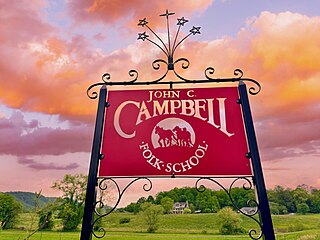
The John C. Campbell Folk School, also referred to as "The Folk School", is located in Brasstown, North Carolina. It is the oldest and largest folk school in the United States. It is a non-profit adult educational organization based on non-competitive learning. The Folk School offers classes year-round in over fifty subject areas including art, craft, music, dance, and nature studies. Established in 1925, the Folk School's motto is "I sing behind the plow".

George Morrison was an Ojibwe abstract painter and sculptor from Minnesota. His Ojibwe name was Wah Wah Teh Go Nay Ga Bo. Morrison's work is associated with the Abstract Expressionist movement in the United States.
Robert Alan Cutietta is best known as an educator, author, researcher, composer, and arts leader. He is the author or co-author of five books and over fifty referereed research articles in the area of music psychology and education. He is also a composer, having written for television shows and movies.

The Akron, OH Metropolitan Statistical Area, sometimes referred to as Greater Akron, is defined by the United States Office of Management and Budget as an area consisting of two counties, Summit and Portage, in Northeast Ohio and anchored by the city of Akron. As of the 2020 census, the MSA had a population of 702,219. The Akron MSA is also part of the larger Cleveland–Akron–Canton, OH Combined Statistical Area, which has a population of 3,633,962 people as of the 2020 census, the largest metropolitan area in Ohio.

Conocotocko, also known by the folk-etymologized name Cunne Shote, was First Beloved Man of the Cherokee from 1760. He succeeded his uncle Conocotocko I upon the latter's death. Pro-French like his uncle, he steered the Cherokee into war with the British colonies of South Carolina, North Carolina, and Virginia in the aftermath of the execution of several Cherokee leaders who were being held hostage at Fort Prince George. He held his title until the end of the Anglo-Cherokee War in 1761, when he was deposed in favor of Attakullakulla.
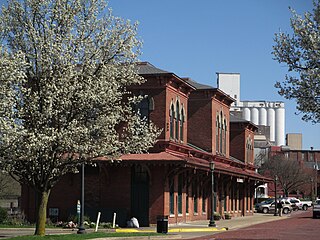
Kent is a city in the U.S. state of Ohio and the largest city in Portage County. It is located along the Cuyahoga River in Northeast Ohio on the western edge of the county. The population was 28,215 at the 2020 Census. The city is counted as part of the Akron metropolitan area and the larger Cleveland–Akron–Canton combined statistical area.

Martins Creek is an unincorporated community in Cherokee County, in the U.S. state of North Carolina.
George Danhires, from Kent, Ohio, has been a sculptor since the 1980s. He has received commissions from private and public organizations. He has made sculptures honoring veterans in several states. Education, humanity, and freedom are other themes of his work.

The visual arts of Sudan encompass the historical and contemporary production of objects made by the inhabitants of today's Republic of the Sudan and specific to their respective cultures. This encompasses objects from cultural traditions of the region in North-East Africa historically referred to as the Sudan, including the southern regions that became independent as South Sudan in 2011.
References
- ↑ "OBITUARY: Edwin George". theonefeather.com. Retrieved 27 December 2024.
- ↑ "Who Was Edwin George? Cherokee Artist". standingrock.net. Standing Rock Cultural Arts. Retrieved 13 January 2025.
- ↑ "Edwin George". cfs.osu.edu. Ohio State University. Retrieved 27 December 2024.
- 1 2 3 Brown, Jeremy (June 23, 2024). "Exhibit at Standing Rock Cultural Arts praises the colorful world of Edwin George". The Portager. The Portager. Retrieved 27 December 2024.
- ↑ "Authors » Elly-Kree George". strongnations.com. Strong Nations Publishing Inc. Retrieved 27 December 2024.
- ↑ McNamara, Barry. "Woman in the Woods". monmouthcollege.edu. Monmouth College. Retrieved 27 December 2024.
- ↑ "Kamama Prairie". arcofappalachia.org. Arc of Appalachia. Retrieved 27 December 2024.
- ↑ "Ohio Folk & Traditional Arts » Profiles". ohioartscouncil.org. Ohio Arts Council. Retrieved 27 December 2024.
- ↑ "Traditions: Edwin George, Painter". pbs.org. PBS. Retrieved 27 December 2024.